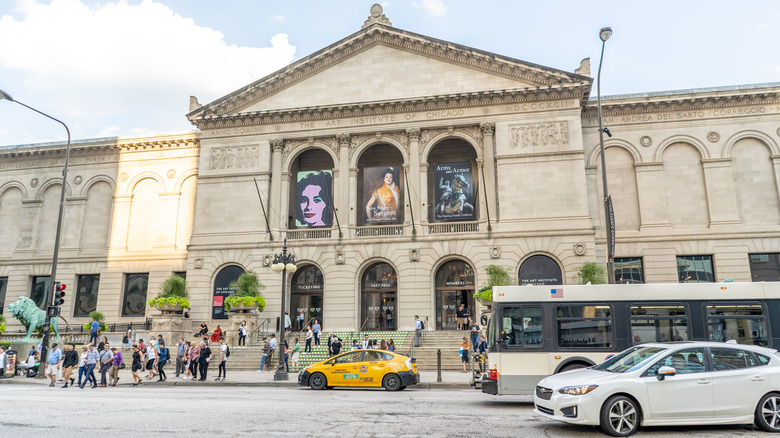Wander through world-class museums
Whether it is your first time in Chicago or your 100th time, you can’t go wrong at any of Chicago’s world-class museums. Tripadvisor travelers put the Art Institute squarely at the top of the list, which isn’t surprising given that 1.5 million visitors pass through their walls each year. Open five days a week (they are closed on Tuesdays and Wednesdays), the museum hosts more than 300,000 pieces of art ranging from ancient to modern and offers free daily tours (and we have some tips for making the most of your visit there).
If art isn’t your thing — or you’ve already visited the iconic museum featured in “Ferris Bueller’s Day Off” — there are three other museums that top the list of favorites: The Museum of Science and Industry, the Field Museum, and the Shedd Aquarium. The Museum of Science and Industry has more than 400,000 square feet of exhibit space and is home to Chicago’s only five-story, domed movie theater. The Field Museum has been delighting visitors since 1894 and has built a collection of more than 40 million artifacts, including impressive dinosaur displays. Shedd Aquarium welcomes 2 million visitors a year who get an up-close look at the way the organization is helping to protect endangered species and rescue animals in need. What better way to spend a rainy day than learning about the creatures who spend their lives in water?
Learn fascinating facts at smaller museums
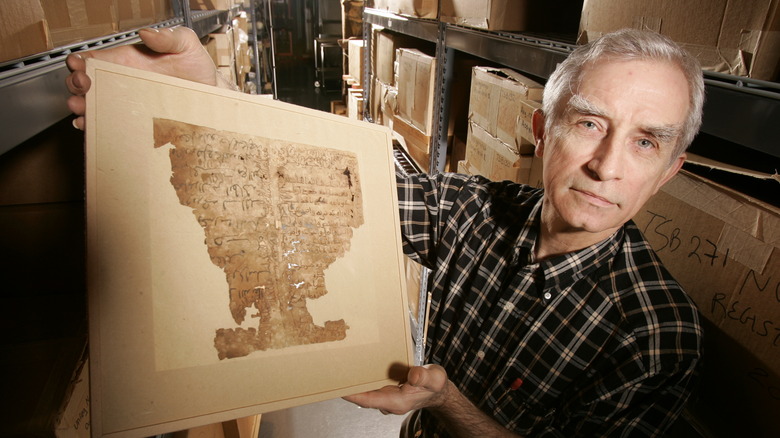
Once you’ve scratched the major museums off your bucket list, there is no shortage of smaller museums that visitors call out as some of Chicago’s best indoor destinations. The ones that top the list of Chicago travelers include the Richard Driehaus Museum, the Medieval Torture Museum, the Chicago History Museum, the American Writers Museum, and the Institute for the Study of Ancient Cultures.
The Richard Driehaus Museum is a delight for all who revel in the architecture of the Gilded Age. Within its walls, you’ll find works by Tiffany Studios, cabinetry from the late 1800s, and Low Art Tile Works. The Medieval Torture Museum takes a more gruesome turn as it challenges visitors to have the courage to face the cruelties of the past. It was the country’s first torture museum. It asks people to discover whether they would be the tormentor or the tormented and to avoid repeating the sins of the past.
The Chicago History Museum celebrates all that has made the Windy City the colorful bastion, from the Great Chicago fire to its mobster past to the culturally diverse settlers of individual neighborhoods. The American Writers Museum is an interactive destination that celebrates all genres of American writing. And if the rain is pouring too hard to keep you from leaving your hotel room, they have virtual exhibits. Once called The Oriental Museum, the University of Chicago’s Institute for the Study of Ancient Cultures has galleries and exhibits spanning 10,000 years of human history.
Let the Chicago Cultural Center welcome you
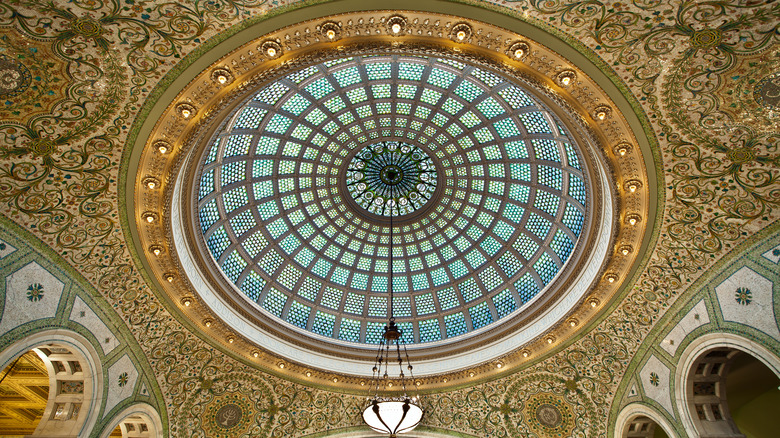
Rudy Balasko/Shutterstock
One of the most visited attractions in Chicago, The Chicago Cultural Center draws people in with free performances of music, dance, theater, and films as well as lectures, art exhibitions, and family events. There are daily free tours and plenty of rotating and permanent exhibitions to visit. There is even a shop dedicated to Chicago artists where you can buy one-of-a-kind gifts and memorabilia to take home with you. The center is home a learning lab, a theater, and private event space.
Since 1897, the Chicago Cultural Center has served as the city’s reception center, the place where the mayor greets celebrities and VIP guests. The country’s first free municipal cultural center, it hosts more than 1,000 programs and exhibitions each year. Sometimes called “The People’s Palace,” it has two stained-glass domes (including the world’s largest stained-glass Tiffany dome) and is filled with imported marble, polished brass, fine hardwoods glass mosaics, and colored stone. It was originally built as a central public library but converted to a cultural center in 1991 when the new Harold Washington Library was built.
Get in on the game at The United Center

Jamie Sabau/Getty Images
Rain or shine, the United Center is the place to go for fans of the Chicago Bulls basketball team or the Chicago Blackhawks hockey team. The owners of those two teams got together in 1988 to build the largest arena in the U.S. In 1994, they cut ribbons to open it, and since then, it has hosted more than 200 events per year. In addition to the basketball and hockey games, major musical stars host their concerts there including Madonna, The Rolling Stones, U2, The Who, and Bruce Springsteen. The United Center has hosted the Democratic National Convention, music festivals, Disney on Ice, college basketball tournaments, and the circus.
Bulls fans will want to make sure they visit the new United Center atrium where they can take in the Michael Jordan statue. Meanwhile, anyone with family members on the spectrum will be relieved to know there is a sensory room, a therapeutic space designed to provide a calming environment for those with sensory sensitivities. Head to the guest relations booth at Gate 2 to request access to this quiet space. Note that when you go, United Arena is a fully cashless arena, so take a debit or credit or have Google Pay/Apple Pay set up on your phone.
Go somewhere that’s green in Chicago’s conservatories
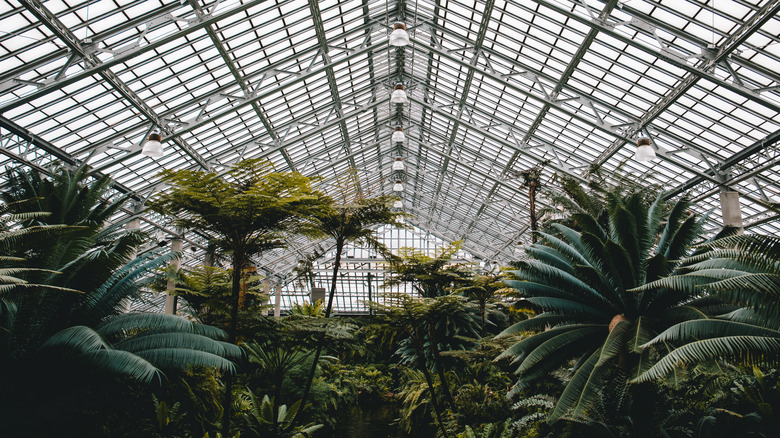
Outtherestudio/Shutterstock
If inclement weather is keeping you from enjoying Chicago’s outdoor parks and gardens, head indoors to the conservatories that visitors say are perfect rainy day destinations. You’ll need reservations to go to Garfield Park Conservatory, but admission is free, and there are eight indoor gardens in what is one of the largest conservatories in the U.S. They opened in 1908 as a natural urban oasis, and throughout the year, they provide educational special events, programs, cultural performances, demonstrations, and hands-on classes.
Lincoln Park is considered the family-friendly neighborhood pick in Chicago and the Lincoln Park Conservatory is a major reason why the Lincoln Park Conservatory is home to a Victorian Glass House filled with exotic plants from around the world in four display houses: The Palm House, Orchid House, Fern Room, and Show House. Like the Garfield Park Conservatory, you need reservations to enter, but admission is free. Designed to be a tropical paradise by the Victorian-era architect Joseph Silsbee, The Conservancy hosted 82,000 visitors in 2022, with more than half of those being out-of-town visitors. In addition to showcasing exotic plants, it helps to grow the flowers needed for city parks.
Pull back the curtain at Chicago theaters
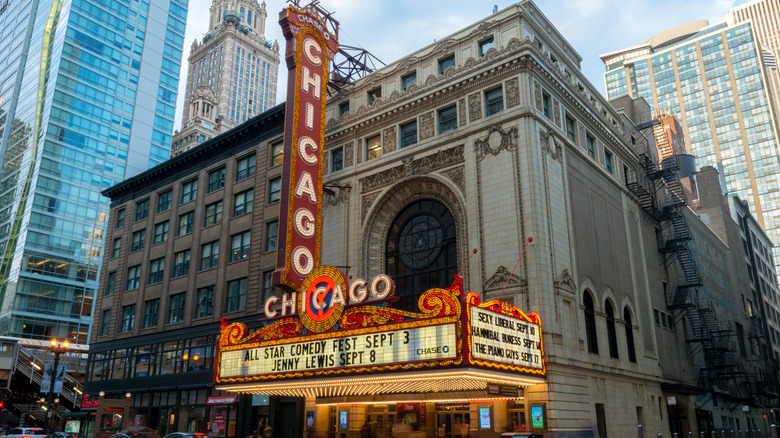
400tmax/Getty Images
Outside of Broadway, Chicago is one of the top U.S. destinations for theater lovers, which is how it got its tongue-in-cheek nickname in the theater world of being the Second City, the same name that the famous improv troupe claimed. Chicago has more than 250 theater companies — five of which have won Tonys. There is almost always a show to see somewhere. Some visitor favorites include The Chicago Theatre, Lookingglass Theatre Company, The Lyric Opera of Chicago, the James M. Nederlander Theatre, and Chicago Shakespeare on Navy Pier.
What makes Chicago special as a theater destination? It is the birthplace of storefront theater and improv comedy. Some of the biggest names in theater, including David Mamet, Tina Fey, Laurie Metcalf, Stephen Colbert, Tracy Letts, and Martyna Majok, got their start in Chicago. The city claims it has more world premieres than any other city in the country. The diversity in shows and locales is part of what makes Chicago such an enticing theater destination. There are the old, architecturally grand theaters downtown and others hidden away in church basements or small storefronts.
You can catch a Broadway musical or an intimate one-person experimental show. On any given day, you can find classics, avant-garde works, and a wide range of dramas, comedies, and family shows. Chicago Plays offers an online aggregate guide to theater in the city.
Tour a historic house of worship
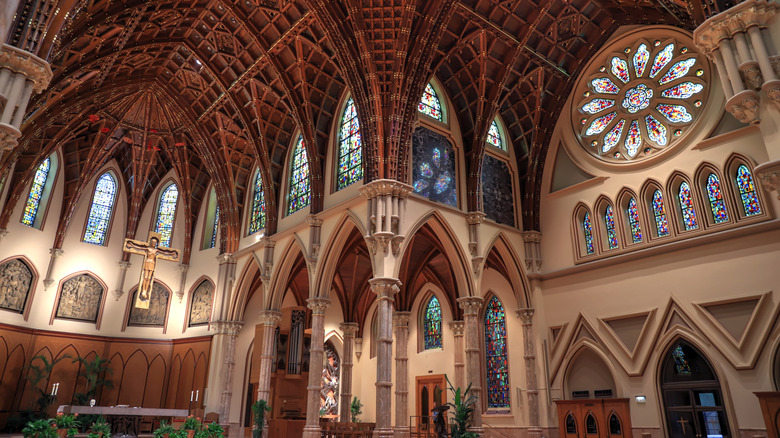
Jbyard/Getty Images
You don’t have to be religious to appreciate the beauty of the architecturally stunning cathedrals and churches in Chicago. Tripadvisor reviewers rank the following buildings as great places to go on a rainy day: Holy Name Cathedral, Holy Trinity Orthodox Cathedral, and Fourth Presbyterian Church. Nor will you want to miss one of the world’s most awe-inspiring houses of worship, the Baha’i House of Worship in a suburb north of Chicago, which is the only Baha’i temple in North America.
Holy Name Cathedral is a Roman Catholic Church where you can request a resident priest light a candle for you or take a guided tour of the world-famous cathedral. The cathedral opened in 1875, replacing the previous cathedral that was destroyed by the Great Chicago Fire. It even has a bit of Chicago’s mob history as Hymie Weiss, a rival to Al Capone, was killed in front of the church in 1926. Holy Trinity Cathedral is listed on the National Register of Historic Places and has been an official Chicago landmark since 1979. Built by Architect Louis H. Sullivan, the cathedral offers 45- to 60-minute tours on intermittent Saturdays. The Orthodox church was founded by immigrants in 1892, and Sullivan used a Siberian church as his guide to building the Cathedral in 1902.
Fourth Presbyterian Church is in an iconic Michigan Avenue building downtown, erected in 1914. If you want to see the sanctuary, visit on Fridays at 11:30 a.m. before the start of their 12:10 free “Noonday” concerts. The church, with its carved stone tympanum, was designed by Ralph Adams Cram, America’s leading Gothic revival architect. In 1995, it added the Loggia, a light-filled gallery on the north side that allows a stairless entry to the sanctuary. In 2012, Fourth Church added a five-story, glass-and-copper addition connected to the original building with a large atrium called Gignilliat Commons.
Observe some of the best of Wright’s architecture
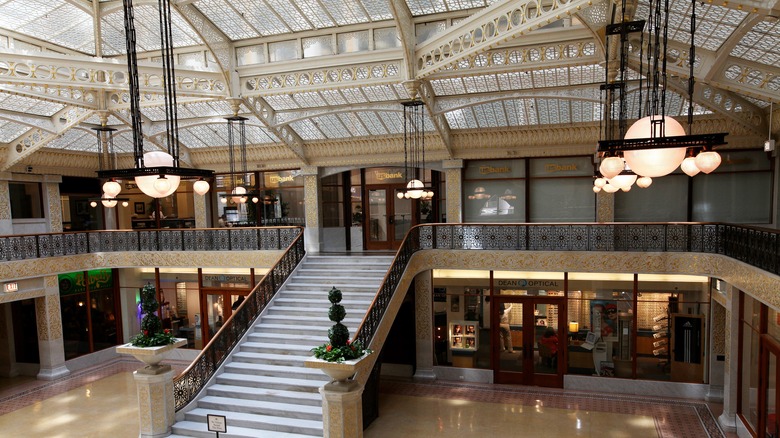
Raymond Boyd/Getty Images
Reeling from the Great Fire of 1871, Chicago set out to rebuild and quickly became the playground of architects. They pioneered steel-frame construction for skyscrapers and the city competed with New York City in the early 20th century to be the city of skyscrapers. But not all its famous buildings are skyscrapers. Chicago proudly boasts a connection with one of America’s imminent architects, Frank Lloyd Wright, who apprenticed in the Windy City and opened his own practice in 1893 from where his fame would grow.
When looking for a rainy day activity, visitors recommend two buildings Wright was intimately involved in: the Rookery Building and the Frank Lloyd Wright Robie House. The Frank Lloyd Wright Trust arranges tours for both buildings. The Rookery Building pre-dates Wright, originally an 11-story business building (a 12th floor was later added) designed by Daniel Burnham and John Root and completed in 1888. Wright led its renovation in 1905 where he encased the iron columns in gilded white marble and added bronze chandeliers to the light court. Thirty years later, William Drummond would add an art deco look and replace Wright’s open-geometric elevator cages with solid bronze doors etched with birds. It is now on the National Register of Historic Places and one of Chicago’s official landmarks.
The Robie House is one of the best examples of Wright’s famous Prairie style and is considered one of the most innovative and important buildings in architectural history. Built in 1910, it kicked off the modernist movement for residential homes. It’s a home where every element is interconnected from the grounds and the building to the furniture and ornamentation. While three families lived in the home as a residence, it would go on to become a classroom, a refectory, a dormitory, and office spaces before becoming the museum that it is today. Both guided and self-guided audio tours are available of the home.
Catch a train at Union Station
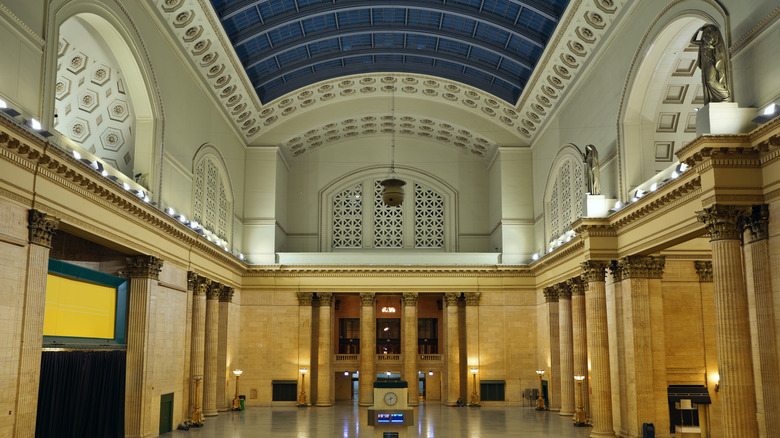
Rudy Balasko/Shutterstock
While most popular among travelers who are trying to get from one place to the next, Union Station attracts tourists who head there to experience the historic building in all its glory — or to eat, shop, and get their shoes shined. The massive, beaux-arts train station is a hub for Amtrak, the Chicago Transit Authority buses, the Chicago L lines, Metra, Pace, and Greyhound. Built in 1925, the station spreads across an entire city block with the Great Hall with its iconic pillars creating the main waiting room space with restaurants and service buildings surrounding it. The Hall is home to two statues by Henry Hering called “Night and Day.” The Hall has a 110-foot-high atrium with a large barrel-vaulted skylight. The Burlington Room is an event space just to the northwest with large columns, chandeliers, four French landscapes, and a mirror.
Filmmakers have been attracted to its halls for years. One of the most iconic scenes in “The Untouchables” from 1987 took place on the stairs of Union Station. Movie fans will also recognize sites from such shows as “The Sting,” “Silver Streak,” “On the Right Track,” “Doctor Detroit,” “My Best Friend’s Wedding,” “Flags of Our Fathers,” “Public Enemies,” and “Man of Steel.” Chicago may be a great walking city, but when the rain starts to pour, the Union Station’s transportation hub will get you wherever you need to go.
Throw back a brew at Goose Island
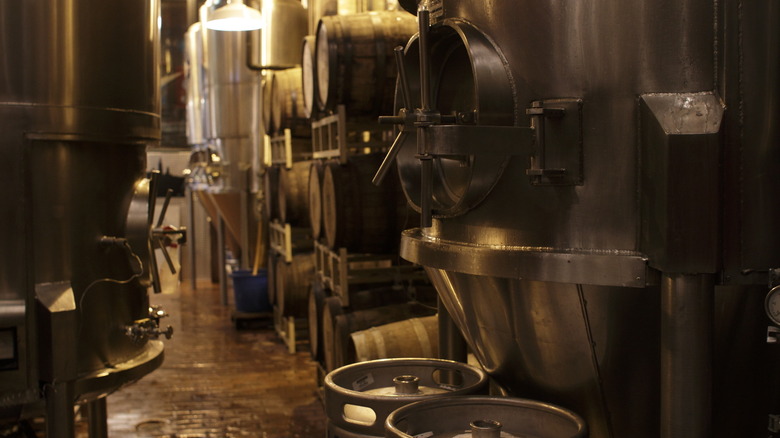
John Gress/Getty Images
The city is filled with incredible dining, from famous steakhouses to Chicago-style pizzerias and everything in between. But if you ask Tripadvisor reviewers, for the best place to eat and drink on a rainy day, they’ll tell you Goose Island Beer Co. There are three locations appealing to craft beer lovers: a brewhouse, a barrel house, and an events space. Whether you are going there for a meal, a brew, or a tour, it’s a chance to experience the beer that sparked the craft beer revolution in the U.S. They exist, they say, “to lead in the craft of brewing by creating award-winning beers that define classic and innovative styles to capture the hearts, imaginations, and palates of beer drinkers.”
Goose Island Beer was founded after the founder, John Hall, took a tour across Europe and was impressed with how many different types of beer there were in each region. He decided that America needed to have its own craft brewing culture. This was in 1988, and after Hall figured out how to make great beer, he invited people in to watch how he did it. In 1995, he opened a larger brewery with another brewpub to follow in 1999.
In 2011, Anheuser-Busch acquired Goose Island Beer Company. You can tour the 1995 brewery, which creates brews using 32 fermenters and more than 15 different types of yeast systems. The Goose Island Barrel House is home to their bourbon barrel-aged beers, a process they pioneered. The Clybourn Brewhouse, which opened in 1988, closed in December 2023 but with a new location: Goose Island at the Salt Shed is to open in 2024.
Shop til you drop
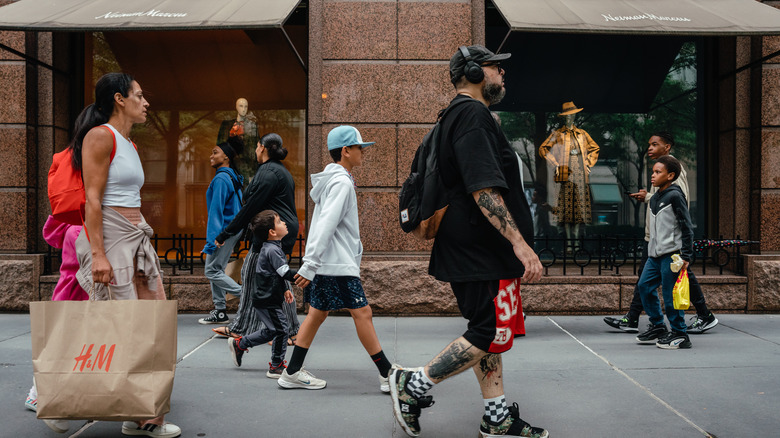
Bloomberg/Getty Images
Escape the rain by visiting Chicago’s famous stores. Choose Chicago describes the Magnificent Mile as one of the world’s most iconic shopping destinations. The district stretches between the Michigan Avenue Bridge and Oak Street and is home to the historic Water Tower Place along with department stores, luxury boutiques, and brand-name retail chains. It is filled with multi-story malls, many of which also house hotels so you never have to head outside to shop for unique and designer gifts. Competing with the Magnificent Mile is the Gold Coast, home to some of the world’s top designer and luxury boutiques.
Not all shopping experiences have to wear the sheen of international commercial brands, however. Hyde Park, the former home of President Barack Obama and the current home of the University of Chicago is filled with such artsy boutique stores as 57th Street Books, Toys et Cetera, The Silver Room, and Dearborn Denim. Andersonville has been dubbed the “shop local capital of Chicago,” where you can find an eclectic collection of more than 100 local vendors at the Andersonville Galleria or visit the largest feminist bookstore in the country, Women and Children First. Pilsen celebrates its Mexican heritage with a wide array of unique shopping options and vintage shops. It’s a place to find unique treasures at such places as Knee Deep Vintage, The Shudio, 606 Records, and Mestiza. There’s even a shop filled with artistic objects for sale at the National Museum of Mexican Art.
Escape the rain in the library
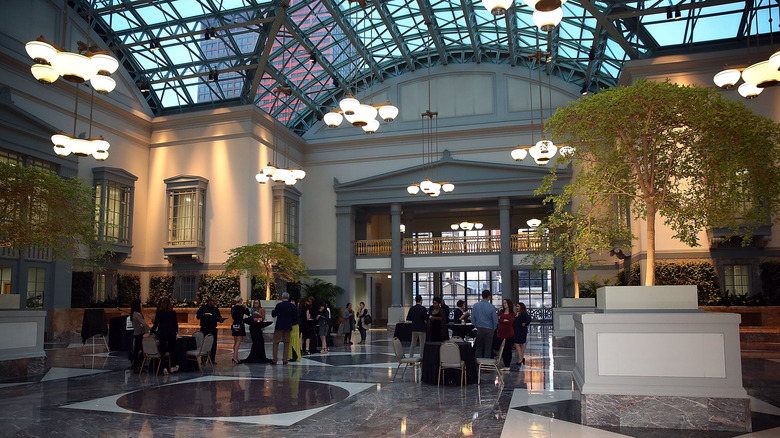
Robin Marchant/Getty Images
What better way to spend a rainy day than curled up with a book? Perhaps that’s why Tripadvisor reviewers suggest a visit to the Harold Washington Library Center, Chicago Public Library’s main library located in the South Loop and named for Chicago’s first Black mayor. It was that mayor, Harold Washington, who first launched the design/build competition for the library in 1987 with a $144 million bond issued to pay for it. The winner was Thomas Beeby from Hammond, Beeby & Babka, Inc. The design is an example of late 20th Century American Architecture and elements throughout the building pay homage to Chicago’s history and culture.
When you go, search out the five massive stone owls that fly atop the library. A 20-foot-high, three-ton great horned owl is over the building’s entrance while the other four 12-foot-high barn owls perch on the corners of the building’s roof. On the ninth floor, you can spend a rainy day touring their winter garden. Other highlights are the special collections, genealogy databases and the Ancestry Library edition, a newspaper microfilm collection, original artwork by more than 50 artists, author events, a Maker Lab, and free music practice rooms with pianos and more than 40,000 volumes of printed music. Browsing the shelves is a great way to stay dry on Chicago’s rainy days.

